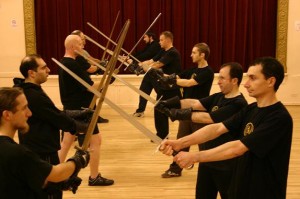
This post came out of one of the forum threads and I thought it made for a somewhat decent overview of some of the different takes on sword combat and fencing that exist. If you’re going to start talking about some of the other sword arts, it’s a good idea to have an idea where they fit:
If you just want to read the thread or the post itself, here’s the link. Where there is a governing body or organization available I’ve also linked to it.
==========
First some terms (I’ve tried to give examples from a wide swath of the community, these groups are not monolithic):
Classical Fencing:
SCA Fencing/SCA Rapier:
SCA Heavy
HEMA/Historical Fencing – (Linking to ARMA)
Examples:
While there is some overlap (like me) these four groups are largely separate. Your average Classical fencer is not a HEMA guy, nor does he play in the SCA as well and so forth. As a result combining all of these groups into one huge “Classical fencing” doesn’t really make a lot of sense.
For example:
SCA fencers are by and large untrained (or self trained). I would argue that approx 75% would not know a good lunge if walked up an hit them in the face. That top 25% or so can be formidable, many of them train seriously, mixing gym time with up to 5 days of fencing per week. In some areas there are tournaments every weekend during the spring and summer, so there is a strong tournament circuit for these fencers. While there are no official rankings, there are fencers who are consistently at the top level during the tournaments at larger pan-SCA events like Pennsic.
HEMA guys are more complicated. HEMA is growing rapidly, and the Europeans have been hosting large international tournaments. The national coaching organizations in Germany, Italy and the UK have started coaching training programs for HEMA. The major fencing suppliers (Negrini, Allstar/Uhlmann, Leon Paul) already have HEMA equipment for sale. Closer to home, Absolute Fencing is coming out with an entire line of HEMA equipment in the next few months.
There, however, significant divisions within the HEMA “crowd.” Broadly there are those who are more into the history and rediscovery parts of HEMA, and those who are more into tournaments and competition. There is space for both groups.
Further, it’s easy to forget as modern fencers with a international governing body that all of these groups are highly regional, and not at all homogeneous. The Polish and Swedish are putting out really cool HEMA tournament fighters, the US less so. The SCA in CA will be completely different from the SCA in Washington.
Now back to Classical Fencing.
I want to make it clear that there is no one definition for Classical Fencing. The community is rather balkenized into a few camps. There is the Evangalista/Crown camp, the Martinez camp, and the SJSU FMP Camp (Gaulger camp)
I belong to camp 3. I too don’t like the strange big actions favored by Crown and Evangalista. (Crown even banned me from his forum). I’m not a big fan of the very pretty, but tempo challenged fencing I’ve seen from the Martinez students I’ve encountered (with a few exceptions). And I think that classical fencers should be able to fence with modern fencers and not do too badly. I’m equally annoyed when classical fencers talk smack about modern fencing, as when modern fencers talk smack about classical/historical fencing, especially when neither side has done both.
I have a friend who recently moved to Atlanta. He’s a SJ FMP Maestro, his exam was 7 hours long and had a board of 7 maestros. It’s about classical fencing, not modern fencing. As there are virtually no classical fencers in Atlanta, he’s picked up modern foil. He’s new to it, unrated, fenced his second tournament last weekend, and he’s having fun. He still hasn’t told anyone about his classical fencing cert, because it shouldn’t matter and because he’s afraid of the backlash.
What do I want you to take away from this rant? (I can’t sleep and am writing this at 3AM)
WE’RE NOT ALL CRAZY! Please don’t assume that the more antagonistic classical fencers represent the whole community, they’re just the people who won’t shut up.
also,
Classical Fencing is not Rapier/Longsword/Fill in the blank The groups may seem similar, but they are very different communities. Lumping them in together makes it very hard to make valid conclusions about the activities.
=============
That’s a decent overview to me. I’d love to get some comments on this also. (Editor’s note: We tried to find a place locally that would teach stage combat and couldn’t find anything nor could we find anything like HEMA in the area but would love to give it a go. I’ve done kendo in the past and it’s great fun – plus seeing the similarities and differences in the different sports is a good exercise.)